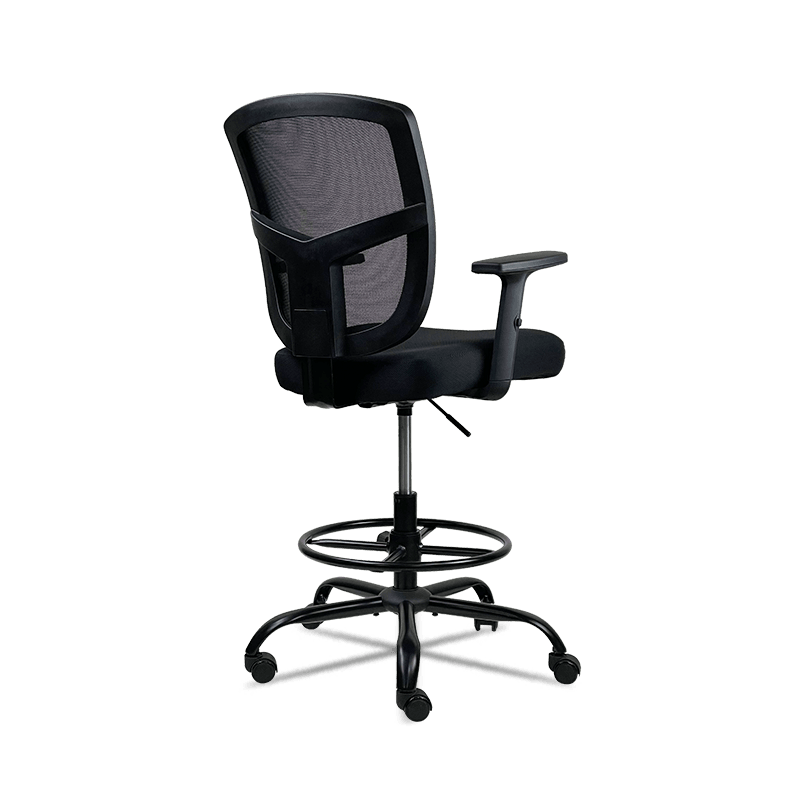Product Consultation
Your email address will not be published. Required fields are marked *
When mesh chairs lack sufficient lumbar support, they can lead to several issues related to posture, comfort, and long-term spinal health. Here's a breakdown of the potential drawbacks and how they can be addressed through design or adjustments:
Potential Drawbacks of Insufficient Lumbar Support
Poor Spinal Alignment
Insufficient lumbar support can lead to improper alignment of the spine, especially the lumbar region. When the lower back doesn't receive adequate support, the spine may flatten out or even curve in unnatural ways, which can cause discomfort and increase strain on the muscles and ligaments.
Impact: Over time, poor spinal alignment can contribute to muscle fatigue, discomfort, and even chronic back pain. It may also increase the risk of developing long-term spinal conditions such as disc herniation or degenerative disc disease.
Increased Pressure on the Intervertebral Discs
Lack of lumbar support can increase pressure on the intervertebral discs in the lower back. This pressure is especially problematic when sitting for extended periods, as it may compress the discs and lead to discomfort, numbness, or tingling.
Impact: Prolonged compression of the discs can exacerbate conditions like sciatica or contribute to the development of herniated discs.
Slouching and Poor Posture
Without adequate lumbar support, people tend to slouch or lean forward to compensate for the lack of lower back support. This poor posture can strain the muscles in the lower back, shoulders, and neck, leading to pain and discomfort.
Impact: Slouching can cause tension in the spine and muscles, leading to poor blood circulation, which can contribute to fatigue, stiffness, and muscle soreness over time.
Increased Risk of Muscle Strain and Fatigue
When lumbar support is insufficient, the muscles in the lower back have to work harder to maintain an upright position. This continuous strain can lead to muscle fatigue, discomfort, and even overuse injuries.
Impact: Chronic muscle strain can contribute to the development of musculoskeletal disorders, including myofascial pain syndrome, which can make sitting for extended periods difficult.

Solutions and Design Adjustments
Adjustable Lumbar Support
Many mesh chairs come with adjustable lumbar support that allows the user to modify the height, depth, and firmness of the support based on their body type and sitting preferences. This customization ensures that the lower back is properly supported, promoting better spinal alignment and reducing strain.
Solution: Users should ensure that the lumbar support is positioned to fill the natural curve of the lower back, maintaining the lumbar lordosis. If the chair doesn't have adjustable lumbar support, consider adding an external lumbar cushion.
Contoured Backrest Design
Chairs designed with a contoured backrest that mimics the natural curve of the spine can help provide better lumbar support even without adjustable features. These chairs are ergonomically designed to fit the natural shape of the back, promoting proper posture and reducing strain on the spine.
Solution: Look for mesh chairs with a backrest that includes a gentle curve to support the lower back, even if lumbar adjustments are minimal.
Additional Padding or Cushion Inserts
Some mesh chairs may have insufficient lumbar support due to minimal padding or lack of cushioning. Adding extra padding or using an adjustable lumbar cushion can help fill the gap and provide the necessary support to the lower back.
Solution: If the chair doesn't offer built-in lumbar support, consider using an ergonomic lumbar cushion designed to fit the natural curve of your spine.
Ergonomic Seat Depth and Backrest Tilt
Adjusting the seat depth and backrest tilt can help in maintaining an upright posture that naturally supports the lumbar spine. Chairs with a tilt mechanism allow users to recline slightly, which can reduce pressure on the lower back while maintaining support.
Solution: Ensure that the seat depth allows the user to sit with their back fully supported by the backrest, and that the tilt mechanism encourages proper spinal alignment while sitting.
Material and Mesh Tension Adjustments
The tension of the mesh fabric in a chair can also play a role in lumbar support. If the mesh is too loose, it may not offer the needed support to the lower back. Chairs with adjustable mesh tension can allow the user to fine-tune the support to their preference.
Solution: Look for mesh chairs with adjustable backrest tension, where you can tighten or loosen the fabric to better support the lumbar region.
Incorporating Dynamic Seating Features
Some modern ergonomic mesh chairs come with dynamic seating features, such as active lumbar support or synchronized recline mechanisms, that adjust with the user’s movement. These chairs provide support as the user shifts their position throughout the day, preventing the spine from staying in a fixed, unsupported position for long periods.
Solution: Invest in mesh chairs with dynamic features to keep the lumbar support aligned with the body during motion, promoting comfort and reducing muscle fatigue.
Use of Lumbar Support Cushions
For those who need more targeted lumbar support, using an external cushion (such as a memory foam or inflatable lumbar cushion) can be an effective solution. These cushions can be attached to the chair and adjusted to the desired position for enhanced comfort.
Solution: Consider adding a lumbar cushion that provides more specific support if the chair’s built-in features are inadequate.
Look for signs in a living room chair that suggest it's not supporting your posture or spinal health well
Nov 05,2024What are the key differences between the seat bases of ergonomic gaming chairs and traditional office chairs?
Nov 20,2024Your email address will not be published. Required fields are marked *






Tangpu, Huzhou, Zhejiang, China
0086-15088380506
Copyright © Anji Mingchuang Furniture Co., Ltd. All Rights Reserved.
